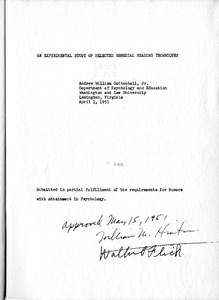| dc.rights.license | In Copyright | en_US |
| dc.creator | Gottschall, Andrew William | |
| dc.date.accessioned | 2023-10-20T18:01:13Z | |
| dc.date.available | 2023-10-20T18:01:13Z | |
| dc.date.created | 1951 | |
| dc.identifier | WLURG038_Gottschall_thesis_1951 | |
| dc.identifier.uri | https://dspace.wlu.edu/handle/11021/36498 | |
| dc.description.abstract | Throughout the past two decades a great deal or attention has been focused upon the correction of poor reading habits. Reliable clinical procedures aimed at correcting defective reading habits have been
brought into use and have done a great deal of good. The question still remains, however, as to whether one technique is more efficient than another. . . . This investigation is concerned with two experiments, each of which were designed to point out the direction in which certain pertinent answers may be found. Both investigations were constructed about one technique used in correcting defective reading. That is the tachistoscopic technique. Reading is a way of using the organ of sight to convey an idea from one man to �the next. Not only, however, is it a means of communication, but it is more basically a way of seeing. Once physical factors are ruled out or compensated for, seeing well or poorly becomes a matter of training. It is a habit pattern whose creation was begun at a relatively early age and which has become well established merely through constant use and reinforcement. The tachistoscope is an instrument which enables the clinician to force his way into this habit pattern. He is then in a position which enables him to retrain the subject's reading habits. . . . Thus the problem is posed. How can the perceptual span of the poor reader be lengthened? The answer? By training the reader to perceive more at one eye fixation. The taehistoscope enables us to do essentially this. It slices away the amount of time that the reader can use to a minimum. With practice he can come to see longer and longer spans of words or numbers per eye-fixation. Probably the most reasonable assumption as to just what mechanism lies behind this improvement is that the subject is aware of the short time interval allowed him and he orients himself to the tachistoscopic work and nothing else. Once this orientation recurs the whole procedure takes on the garb of ordinary learning or in this case the better word in terms of description alone might be retraining. The effects of this learning or retraining then transfer to an actual reading situation. The "How" and "Why" of this transfer is another aspect of the total problem which future experimental work may answer. [From introductory section] | en_US |
| dc.format.extent | 42 pages | en_US |
| dc.language.iso | en_US | en_US |
| dc.rights | This material is made available for use in research, teaching, and private study, pursuant to U.S. Copyright law. The user assumes full responsibility for any use of the materials, including but not limited to, infringement of copyright and publication rights of reproduced materials. Any materials used should be fully credited with the source. | en_US |
| dc.rights.uri | http://rightsstatements.org/vocab/InC/1.0/ | en_US |
| dc.subject.other | Washington and Lee University -- Honors in Psychology | en_US |
| dc.title | An Experimental Study of Selected Remedial Reading Techniques | en_US |
| dc.type | Text | en_US |
| dcterms.isPartOf | WLURG038 - Student Papers | en_US |
| dc.rights.holder | Gottschall, Andrew William | en_US |
| dc.subject.fast | Reading -- Remedial teaching | en_US |
| dc.subject.fast | Tachistoscope | en_US |
